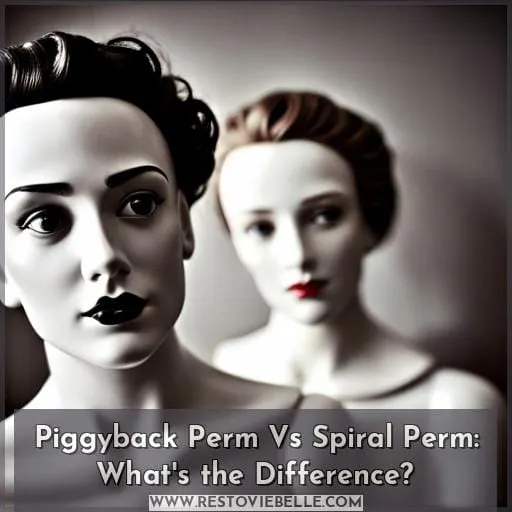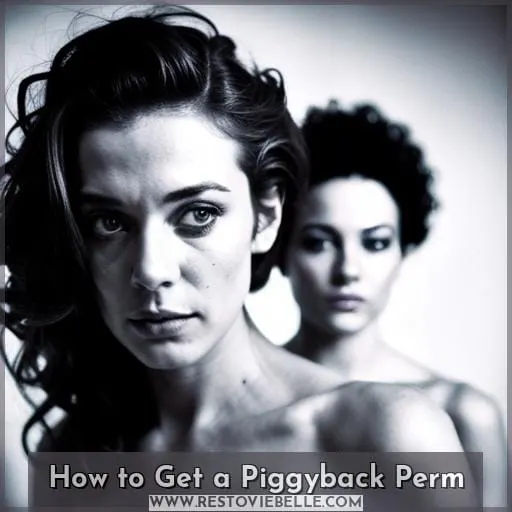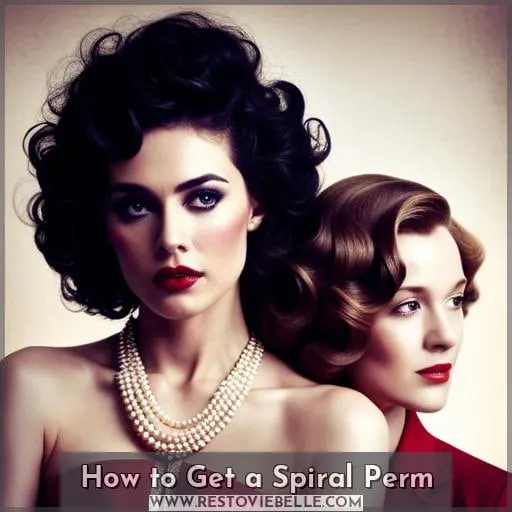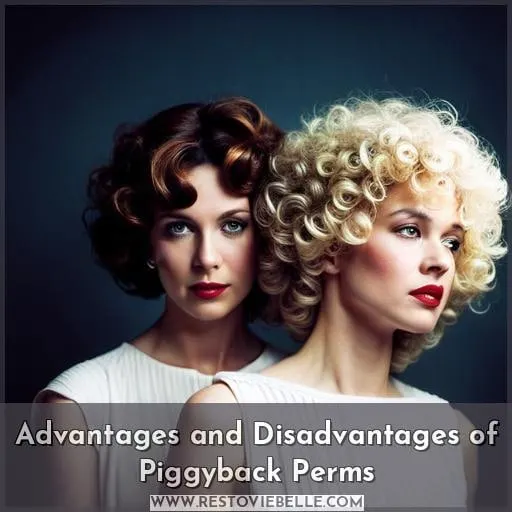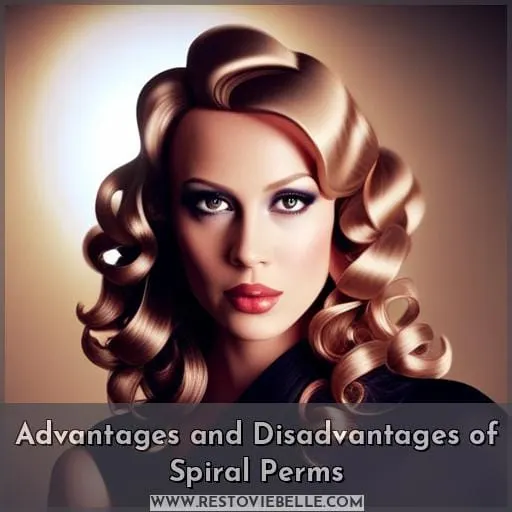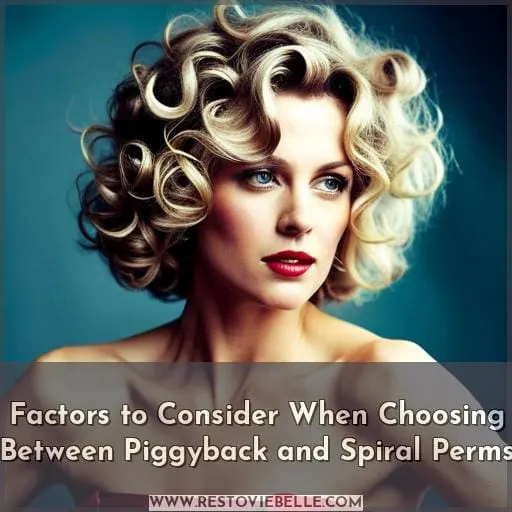This site is supported by our readers. We may earn a commission, at no cost to you, if you purchase through links.
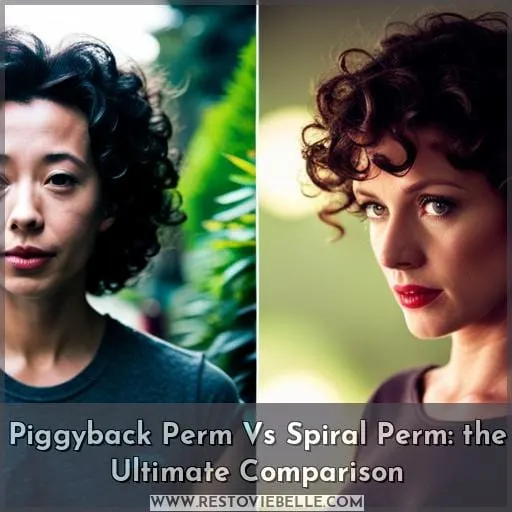 Imagine having the perfect curls that suit your style and make you feel confident.
Imagine having the perfect curls that suit your style and make you feel confident.
That’s where this ultimate comparison between piggyback perm and spiral perm comes in. In just a few minutes, you’ll learn the key differences, ideal hair lengths, maintenance requirements, and more for each type of perm.
Get ready to unlock the secrets to achieving stunning curls that will turn heads wherever you go.
Table Of Contents
- Key Takeaways
- Piggyback Perm Vs Spiral Perm: What’s the Difference?
- How to Get a Piggyback Perm
- How to Get a Spiral Perm
- Advantages and Disadvantages of Piggyback Perms
- Advantages and Disadvantages of Spiral Perms
- Factors to Consider When Choosing Between Piggyback and Spiral Perms
- Frequently Asked Questions (FAQs)
- Conclusion
Key Takeaways
- Piggyback perm utilizes two different sizes of rods for a versatile and natural-looking curl pattern.
- Spiral perm focuses on creating defined, uniform curls with single-size rollers.
- Piggyback perm is ideal for naturally textured medium to long hair, while spiral perm can be done on various hair lengths.
- Piggyback perm requires low maintenance and offers natural and dynamic curls, while spiral perm requires medium maintenance and provides tight and defined curls.
Piggyback Perm Vs Spiral Perm: What’s the Difference?
Let’s dive into the differences between a piggyback perm and a spiral perm.
The procedure and technique used for each type of perm vary, resulting in different curl patterns and overall looks. Additionally, ideal hair length and type play a role in determining which perm is best suited for you, as well as the level of maintenance required to upkeep the curls.
Procedure and Technique
When it comes to the procedure and technique, there are distinct differences between getting a piggyback perm and a spiral perm.
- Rod Selection: Piggyback perms use two different sizes of rods, while spiral perms use single-size rollers.
- Chemical Choices: Both types of perms involve using chemical solutions to break down hair’s disulfide bonds and create new curl patterns.
- Styling Variations: Piggyback perms offer more versatility for creating different hairstyles, while spiral perms specifically focus on defined curls.
- Curl Maintenance: Piggyback perms require low maintenance due to their natural-looking curls, whereas spiral permed hair may require medium upkeep.
Both piggyback and spiral perm techniques have evolved with trends over time as people seek liberation through various styles that empower them in understanding who they truly are.
Curl Pattern and Result
To understand the difference in curl patterns and results between a piggyback perm and a spiral perm, let’s take a closer look at how each technique transforms your hair.
Here is a table comparing the curl pattern, defined curls, advantages of piggyback perms, and disadvantages of spiral perms:
| Curl Pattern | Defined Curls | Advantages of Piggyback Perms | Disadvantages of Spiral Perms | |
|---|---|---|---|---|
| Piggyback Perm – Non-uniform curls – Normal volume – Suitable for naturally textured medium to long hair – Natural and dynamic curls | ||||
| Spiral Perm Uniform curls Voluminous Specifically employed for defined curls Creates dramatic eye-catching curl |
In summary:
- Piggyback perms create non-uniform natural-looking dynamic curls with normal volume suitable for medium to long naturally textured hair.
- Spiral perms create uniform voluminous tight corkscrew-like coils that add drama to your look.
- Each type has its own advantages such as styling versatility (piggybank), or defining specific types of hairstyles (spiral).
- Maintenance-wise both require some upkeep but can last up to six months depending on individual factors.
Ideal Hair Length and Type
For the ideal hair length and type for each perm, consider your hair’s natural texture and length.
- Texture Preferences:
- Piggyback perms work best on naturally textured hair, while spiral perms can be done on straight to textured hair.
- Length Versatility:
- Piggyback perms are ideal for medium to long lengths, while spiral perms can be done on short to long lengths.
- Styling Flexibility:
- Piggyback perms allow for different hairstyles due to their versatility, whereas spiral perms create defined curls.
- Curl Maintenance:
- Both perm methods require maintenance but piggyback curls tend to have a more natural look with less uniformity compared to spirals
Maintenance and Longevity
If you want to know how the maintenance and longevity of piggyback perms differ from spiral perms, it’s important to understand their distinct characteristics.
| Piggyback Perms | Spiral Perms |
|---|---|
| Low maintenance | Medium maintenance |
| Lasts up to 6 months | Lasts up to 6 months |
| Offers natural and dynamic curls | Provides tight and defined curls |
Understanding these differences will allow you to make an informed decision based on your styling preferences, aftercare routine, and seasonal considerations.
How to Get a Piggyback Perm
To get a piggyback perm, start by deciding on the sizes of the perm rods you want to use.
Next, choose an appropriate perm kit based on your hair type and texture; alkaline kits are generally recommended for thick or textured hair.
Finally, follow a specific wrapping pattern where you start from the front and curl mid-length sections using smaller rods before piggybacking larger rods for added volume at the roots.
Choosing the Right Perm Rod Sizes
When getting a piggyback perm, it’s important to choose the right perm rod sizes for achieving the desired curl pattern and volume in your hair.
The size of the rods will determine how tight or loose your curls will be.
For a more natural and dynamic look, consider using a combination of larger and smaller rods. This allows for customization in creating different patterns throughout your hair.
It’s also essential to consider texture compatibility when selecting rod sizes to ensure that you achieve optimal results with your specific hair type.
By choosing the right perm rod sizes, you can enhance styling versatility and maximize curl longevity in piggyback perms.
Selecting the Appropriate Perm Kit
To get a piggyback perm, you’ll need to select the appropriate perm kit that suits your hair type and desired results.
Here are four key factors to consider when choosing the right perm kit for your piggyback perm:
- Rod Selection: Consider the size of rods you want for your curls. Smaller rods create tighter curls, while larger ones produce looser waves.
- Chemical Choices: Pay attention to the chemicals used in the perm kit. Different formulas cater to different hair textures and strengths.
- Stylist Expertise: Consult with an experienced stylist who understands how to work with piggyback perms and can recommend suitable products based on your specific needs.
- Hair Texture: Take into account your natural hair texture when selecting a perming solution as it will affect how well it holds curl after processing is complete.
How to Get a Spiral Perm
To achieve a spiral perm, start by sectioning your hair into smaller parts for easier rolling.
Choose the correct rod size based on your desired curl pattern and hair length.
Vertical wrapping is essential to create the corkscrew effect, so make sure to roll the hair tightly around each rod from root to tip.
Sectioning the Hair for Rolling
Start by dividing your hair into sections for rolling when getting a spiral perm.
Precision sectioning is crucial to ensure an even and efficient rolling process.
To achieve the desired curl pattern, it’s important to create patterned segmentation throughout your hair.
This involves dividing your hair into smaller, manageable sections that are compatible with the length of your hair.
By carefully sectioning the hair and following a specific rolling pattern, you can achieve stylish flexibility and maximize the effectiveness of the spiral perm procedure.
Choosing the Correct Rod Size
Now let’s talk about choosing the correct rod size for your spiral perm.
When it comes to getting a spiral perm, selecting the right rod size is crucial in achieving the desired curl pattern and overall look.
- Hair Length:
For shorter hair lengths, smaller rods are recommended as they create tighter and more defined curls. On the other hand, longer hair can benefit from larger rods for looser and cascading curls.
- Curl Intensity:
If you desire bouncy and voluminous curls, opt for smaller rods that will provide more curl definition and intensity.
3.Rolling Technique Preference:
Your preferred rolling technique also plays a role in determining which rod sizes to use. If you prefer tight spirals or corkscrew-like curls, go for smaller diameter rods that can wrap tightly around sections of hair.
By considering these factors along with your styling goals, you’ll be able to choose the perfect rod sizes that suit your needs during a spiral perm process.
Advantages and Disadvantages of Piggyback Perms
When considering piggyback perms, there are several advantages and disadvantages to keep in mind.
On the positive side, piggyback perms create a modern wave or curl pattern that lasts up to 6 months and adds volume at the roots.
However, it’s important to note that piggyback perms can be challenging for short hair due to the complexity of sectioning and rolling two rods on a single strand.
Advantages
Now let’s delve into the advantages of piggyback perms, so you can see why this technique is favored by many for achieving modern wave or curl patterns.
The dual-rod wrapping grants greater styling versatility, allowing you to customize tightness and texture.
Maintenance is easier too since piggyback perms enhance rather than overly curl natural hair patterns.
Varying rod sizes also enables you to spotlight face-framing pieces or amplify volume at the crown to align with trendy preferences.
Disadvantages
Let’s delve into the disadvantages of piggyback perms and explore their potential drawbacks.
- Retro Vibes: While some people love the nostalgic feel, others may find that the spiral styling of a piggyback perm gives off retro vibes reminiscent of 80s hair trends.
- Length Considerations: Piggyback perms work best on medium to long hair lengths, making them less suitable for those with short hair who desire tight curls.
- Maintenance Contrasts: Compared to other types of perms like spiral perms, maintaining a piggyback perm can be more challenging due to its dual-rod process and non-uniform curl pattern.
Advantages and Disadvantages of Spiral Perms
When considering spiral perms, it’s important to weigh the advantages and disadvantages of this particular style.
Spiral perms offer a modern twist on traditional perms, creating corkscrew curls that are dynamic and catchy.
One advantage of spiral perms is their styling versatility. They can be customized for various hair lengths, from short to long, allowing individuals with different hair textures to achieve voluminous roots and defined curls.
Another advantage is the curl longevity they provide. Spiral perm curls can last up to six months with proper maintenance.
However, there are also some drawbacks to consider when opting for a spiral perm.
One disadvantage is that they may not be suitable for those looking for loose waves or soft curls since they tend to create tight corkscrew-like patterns instead.
In summary:
Advantages:
- Styling Versatility – Suitable for various hair lengths and textures.
- Curl Longevity – Curls can last up to six months.
- Trend Impact – Creates dynamic and eye-catching corkscrew curls.
Disadvantages:
- Hair Texture Limitation – Not ideal if you prefer loose waves or soft curls.
Despite these potential downsides, the trend impact created by spiral perms can’t be denied as it adds an element of youthfulness while providing volume and defining natural texture
Factors to Consider When Choosing Between Piggyback and Spiral Perms
When choosing between a piggyback perm and a spiral perm, there are several factors to consider.
First, the size of the rods and wrapping patterns used in each type of perm will determine the final look of your curls.
Additionally, your hair type and length will play a role in determining which perm is best suited for you.
Lastly, maintenance requirements and versatility should also be taken into account when making your decision.
Rod sizes and patterns
To determine the best perm technique for your desired curls, consider the rod sizes and patterns that will suit your hair type and length.
Rod selection plays a crucial role in achieving the desired curl dynamics.
Spiral perms use single-size rollers for defined and uniform curls, while piggyback perms utilize two different sizes of perm rods to create volume at the roots and curls throughout the hair.
These choices also affect styling versatility and maintenance tips, so choose wisely based on your preferences.
Hair type and length
If you’re considering a piggyback or spiral perm, it’s important to take into account your hair type and length.
Texture versatility – Both suit straight to curly hair.
Length considerations – Spiral good for short hair; piggyback better for long.
Styling preferences – Spiral for defined curls; piggyback for soft waves.
Maintenance levels – Spiral higher maintenance than piggyback.
Maintenance and versatility
You’ll also want to weigh the upkeep and adaptability of each technique before deciding.
When it comes to maintenance, piggyback perms are low maintenance compared to spiral perms. Piggyback perms require less daily care and touch-ups due to their natural-looking and dynamic curls. On the other hand, spiral perms may require more regular styling techniques to maintain their tight and springy curls.
Additionally, consider seasonal variations as well as your hair type, texture, and desired volume when making your choice between these trendy curling methods for multi-texture curls.
When considering which perm technique is right for you – whether it’s a piggyback perm or a spiral perm – there are several factors you need to take into account in order make an informed decision that suits your individual needs.
One important factor is the maintenance required for each style after getting the initial perming treatment done at the salon. While both styles offer long-lasting results that can last up 6 months with proper care, they do have different levels of day-to-day upkeep involved.
Piggyback perms tend to be lower maintenance compared Spiral Perms because they create naturally looking dynamic waves rather than uniform corkscrew-like spirals seen with Spiral Perms. While some minor touch-ups may be needed occasionally depending on personal preference or hair growth rate, the overall daily care routine tends not very time-consuming.
As such, pigyybankperms allows one more freedom in terms of hairstyling options.
On the contrary, Spiral Perm requires slightly higher level daily attention due its tighter, curls patterns. The coils produced by Spiral Perm necessitate more specific styling techniques like using particular brushes, diffusers, and products specifically designed curly hairstyles.
These additional steps could add extra minutes onto morning routine especially if person prefers perfectly defined ringlets.
Consideration should also be given towards seasonal variations. Piggyback perms may provide more versatility when it comes to adapting your hairstyle for different seasons or occasions, as the non-uniform curls can be styled in various ways depending on personal preference and current trends.
Spiral perms, with their tight and bouncy curls, have a more specific look that may not lend itself as well to certain styles or seasons.
Ultimately, the choice between piggyback perm and spiral perm will depend on factors such as hair maintenance preferences, the desired curl pattern, textured hair outcome, and adaptability for different styling techniques.
It’s important to consult with a professional stylist who can assess your hair type, length, and goals before making a decision. This way, you can ensure that you choose the right technique that best suits your lifestyle while embracing trendy, curling methods.
Frequently Asked Questions (FAQs)
How long does a piggyback perm typically last?
A piggyback perm typically lasts up to six months, allowing you to enjoy the modern wave or curl pattern for an extended period.
Can a piggyback perm be done on short hair?
Yes, a piggyback perm can be done on short hair.
It offers a modern wave or curl pattern and adds volume to shorter lengths.
However, the process may be more complex due to the limited hair length.
Are spiral perms suitable for fine or thin hair?
Spiral perms can be suitable for fine or thin hair.
The corkscrew curls created by spiral perms add volume and body to the hair, making it appear fuller and more voluminous.
What is the maintenance required for a spiral perm?
You’ll need to get trims every 6-8 weeks and use moisturizing shampoos and conditioners to maintain your spiral perm.
Avoid over-washing, brushing when wet, or using heat styling to keep the curls bouncy.
Schedule occasional touch-up perms as your new growth comes in.
Can you combine a piggyback perm and a spiral perm for a unique look?
Unfortunately, combining a piggyback perm and spiral perm isn’t recommended. The different rod sizes and wrapping techniques don’t blend well together, leading to inconsistent and unnatural curls.
Conclusion
To achieve the perfect curls that suit your style and boost your confidence, it’s important to understand the key differences between piggyback perms and spiral perms.
While piggyback perms offer a more natural and voluminous curl pattern, spiral perms create defined and uniform curls.
Factors such as hair length, maintenance requirements, and desired curl pattern should be considered when choosing between the two.
By following the appropriate techniques and selecting the right perm rods, you can achieve stunning curls that will make heads turn wherever you go.
So, whether you opt for a piggyback perm or a spiral perm, get ready to rock your gorgeous curls.

